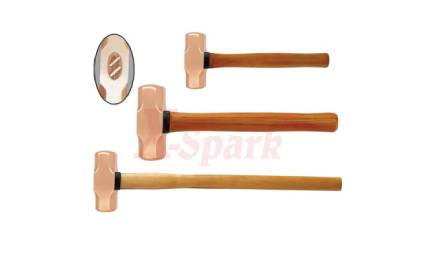Non-sparking hammer generally consists of hammerhead and hammer handle. The length of the hammer handle of the explosion-proof copper hammer is generally fixed, and the length of the hammer handle cannot be adjusted according to different usage conditions. The explosion-proof copper hammer is used in petroleum, natural gas, CNOOC, coal mines, oil production, gas production, power plants, aluminum plants, metallurgy, Storage, transportation, and other large flammable and explosive places knock on workpieces, install machinery, and drill rocks and gravel when driving mountains and roads. Explosion-proof copper hammer is one of the commonly used hammers in explosion-proof tools. Explosion-proof tools are made of aluminium bronze and beryllium bronze.
Explosion-proof tool is a special tool. It is made of multi-element non-ferrous metal with copper as the base material. Some explosion-proof tools are specially designed. All have requirements for the use, maintenance, storage, transportation and transportation of explosion-proof tools. Only by fully understanding it, choosing it properly, and using and storing explosion-proof tools correctly can we fully utilize the various performance advantages of explosion-proof tools.

Non-Sparking Hammer
Explosion-proof hand tools all have different strengths. Explosion-proof casings are strictly forbidden to be overloaded. Except for knocking wrenches, other tools must not be struck, so as to avoid overloading and deformation and affecting normal use. When using explosion-proof hand tools, you should choose their varieties and specifications according to your needs. Do not use small belts or use explosion-proof tools as steel tools. It should be noted that when using adjustable wrenches, pipe wrenches, and open wrenches, Pay attention to the requirements of the direction of the force, and do not make any knobs. When using a tool with a blade, first measure the hardness of the workpiece. It is prohibited to use it when the hardness is higher than the hardness of the tool. When the workpiece is tightened by motor, fixed or corroded, and no other measures are taken before using the explosion-proof manual tool, the user should be prohibited to avoid damage to the tool. Explosion-proof hand tools are explosion-proof live wrench, explosion-proof pipe wrench, explosion-proof copper hammer, explosion-proof plum blossom wrench, explosion-proof open-end wrench, explosion-proof fire axe, explosion-proof shovel, etc.
Among the explosion-proof tools, the explosion-proof pipe wrench is also one of the commonly used tools. The process before the explosion-proof tool (explosion-proof pipe wrench) uses casting, polishing, and then painting. However, some customers will say that I do n’t want to paint. I want the original copper colour. The original copper colour requires the surface treatment of our explosion-proof tools to be good, and there should be no potholes, then what to do, after repeated by our technical staff, the original copper colour of the explosion-proof tools now uses the new production technology sanding process. Frosting refers to the process of using abrasives to grind our explosion-proof tools with machinery so that the surface of the explosion-proof tools presents a series of uniform rough surfaces and the polished surface formed by polishing our explosion-proof tools before appears to be subtle and generous. metallic feel. Glossy and stylish.
The nature of explosion-proof tools in the field of prevention is very important. Explosion-proof tools are the key to facilities, so it is necessary to ensure the critical performance of explosion-proof tools.
Explosion-proof tools have a bright surface after polishing, and the active metal molecules on the surface are exposed to the air and quickly oxidize to black, and then rust, so the explosion-proof tools are degreased and polished before finishing The dehydration and drying of the two are indispensable. Store the explosion-proof tool in a dry place so that parts of the explosion-proof tool will not be damaged. In our daily work, the surface attachments of the explosion-proof tools should be treated after 20 consecutive taps. Wipe clean before use. Never use it continuously to avoid prolonged friction that will heat the tool, which may cause damage Our explosion-proof tools must wipe the dirt and deposits on the surface after use. Explosion-proof tools such as wrenches cannot be used with excessive force, and can not use sleeves or other metal bar materials to lengthen the arm and use the hammer to hit the knob fastener. The cutting edge type explosion-proof tools should be placed in the water tank to lightly touch the grinding wheel for sharpening. Do not use excessive force and contact the grinding wheel for too long. In the operation of the explosion-proof tools, the debris and oxides on the working surface are prevented from impact by the third party.
评论
发表评论